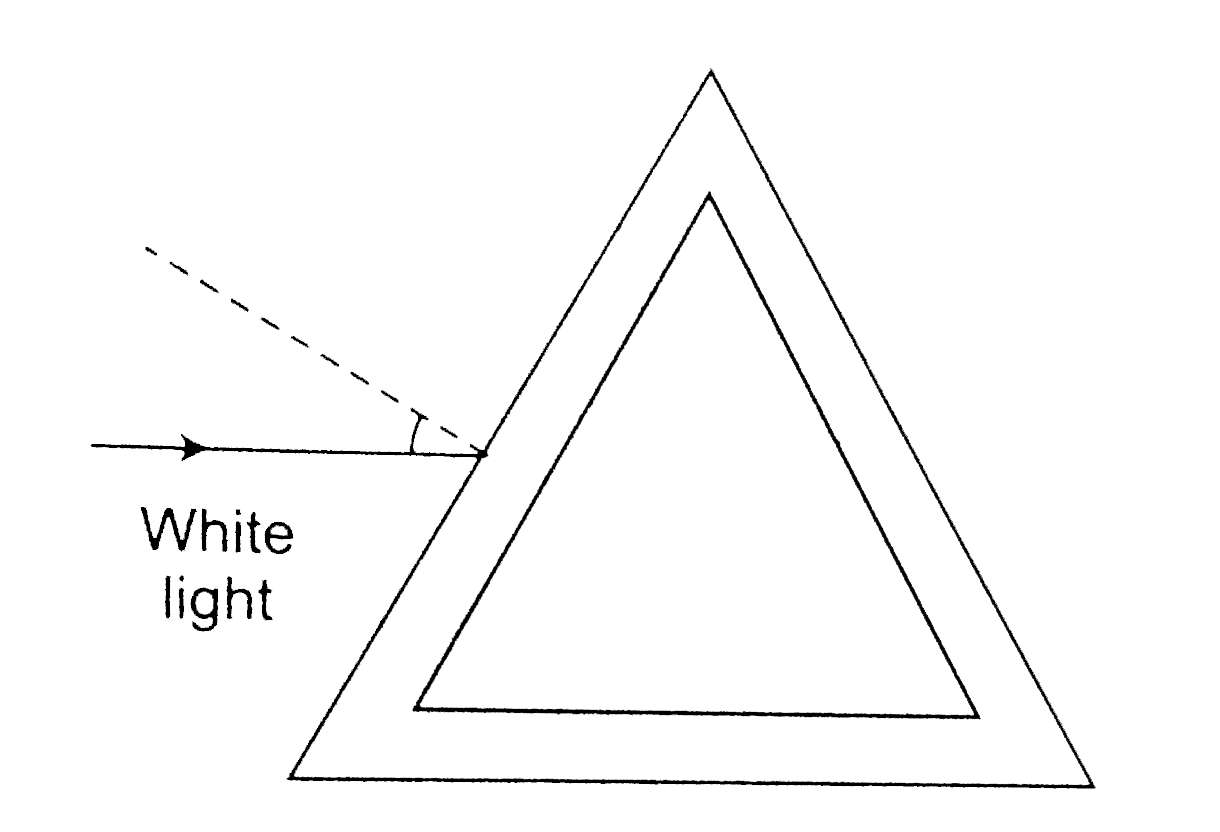Can a beam of white light when passed through a hollow prism give spectrum? Explain.
To determine whether a beam of white light can produce a spectrum when passed through a hollow prism, we need to analyze the behavior of light as it travels through different media.
1. Understanding the Prism: A prism is typically made of a transparent material, such as glass, which has a different refractive index than air. This difference in refractive index is crucial for the dispersion of light.
2. White Light Composition: White light is composed of multiple colors (spectrum) that can be separated when passing through a medium with varying refractive indices.
3. Refraction and Dispersion: When white light enters a prism, it bends (refracts) due to the change in medium from air (lower refractive index) to glass (higher refractive index). Different colors of light refract at different angles due to their varying wavelengths, leading to the dispersion of light into a spectrum.
4. Hollow Prism Condition: In the case of a hollow prism, the inside of the prism is filled with air. Therefore, when white light enters the prism, it travels from air to air (since both the outside and inside are air). There is no change in the refractive index.
5. Conclusion: Since there is no change in medium (both inside and outside the prism are air), there is no refraction or dispersion of light. Thus, a spectrum cannot be produced when white light passes through a hollow prism.
Final Answer:
No, a beam of white light cannot produce a spectrum when passed through a hollow prism because it travels from air to air, resulting in no change in refractive index and hence no dispersion of light.
---
No, a beam of white light cannot produce a spectrum when passed through a hollow prism because it travels from air to air, resulting in no change in refractive index and hence no dispersion of light.
Topper's Solved these Questions
- BOOK - AAKASH SERIESCHAPTER - RAY OPTICSEXERCISE - PROBLEMS ( LEVEL-I)57videos
RAY OPTICS
- BOOK - AAKASH SERIESCHAPTER - RAY OPTICSEXERCISE - PROBLEMS ( LEVEL-II)60videos
RAY OPTICS
- BOOK - AAKASH SERIESCHAPTER - RAY OPTICSEXERCISE - EXERCISE (SHORT ANSWER QUESTIONS )24videos
RAY OPTICS
- BOOK - AAKASH SERIESCHAPTER - PRACTICAL PHYSICSEXERCISE - LECTURE SHEET LEVEL-II (ADVANCED) Linked Comprehension Type Questions4videos
PRACTICAL PHYSICS
- BOOK - AAKASH SERIESCHAPTER - SEMICONDUCTOR DEVICESEXERCISE - EXERCISE - III3videos
SEMICONDUCTOR DEVICES
Similar Questions
Knowledge Check
- Question 1 - Select One
When a beam of white light is passed through sodium vapours and then through a spectrometer, spectrum so obtained has two dark lines present in the yellow region. This spectrum is called :
AA) band spectrumBB) continuous spectrumCC) absorption spectrum of sodiumDD) emission spectrum of sodium
The band of seven colours obtained on a screen when white light passes through a prism is called spectrum. ____
View SolutionA ray of white light is passed through a glass prism and a spectrum is obtained on a screen.
(a) Name the seven colours of the spectrum in order.
(b) Do the colours have the same width in the spectrum ?
(c) Which colour of the spectrum of white light deviates (i) the most, (ii) the least?View SolutionIf a beam of light is passed through true solution, then it is
View SolutionA thin prism of angle 6.0∘,ω'=0.07andμy'=1.50 is combined with another thin prism having ω=0.08andμy=1.60. The combination produces no deviation in the mean ray. (a) Find the angle of the second prism. (b) Find the net angular dispersion produced by the combination when a beam of white light passes through it. (c) If the prisms are similarly directed, what will be the deviation in the mean ray ? (d) Find the angular dispersion in the situation described in (c).
View SolutionStatement-1 : When a white light passes through a prism it forms a spectrum of seven colours.
Statement-2 : The refractive index for different colour of light is different for the material of prism.View SolutionA glass prism of angle A=60∘ gives minimum angle of deviation θ≈30∘ with the maximum error of 1∘ when a beam of parallel light passed through the prism during an experiment. Find the permissible error in the measurement of refractive index μ of the material of the prism.
View SolutionA narrow beam of white light goes through a slab having parallel faces.
View Solution


